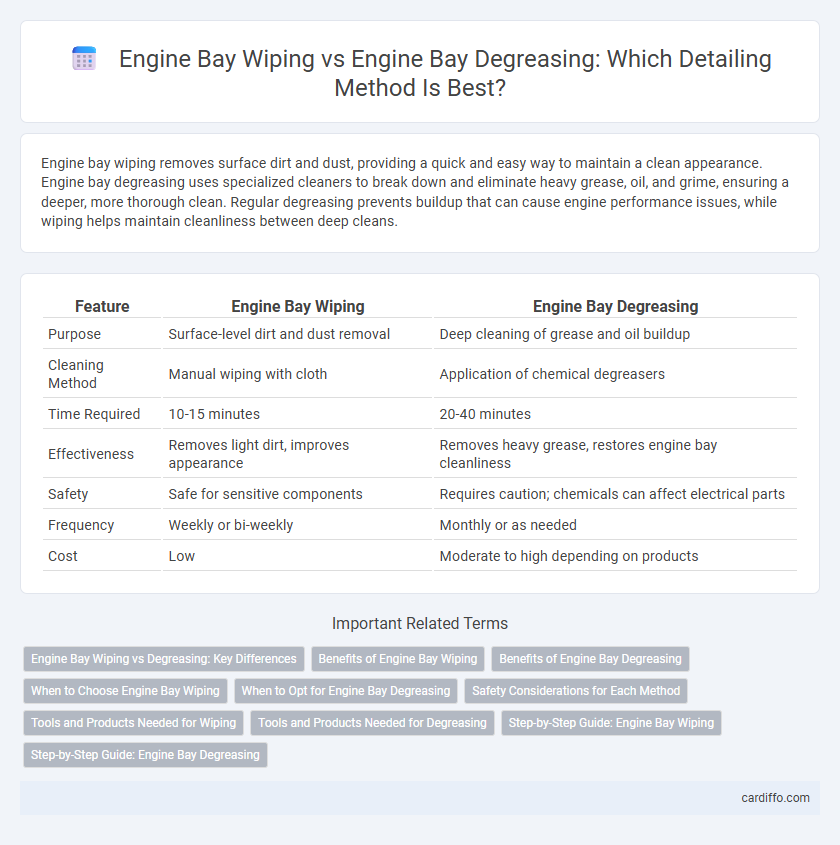Engine bay wiping removes surface dirt and dust, providing a quick and easy way to maintain a clean appearance. Engine bay degreasing uses specialized cleaners to break down and eliminate heavy grease, oil, and grime, ensuring a deeper, more thorough clean. Regular degreasing prevents buildup that can cause engine performance issues, while wiping helps maintain cleanliness between deep cleans.
Table of Comparison
| Feature | Engine Bay Wiping | Engine Bay Degreasing |
|---|---|---|
| Purpose | Surface-level dirt and dust removal | Deep cleaning of grease and oil buildup |
| Cleaning Method | Manual wiping with cloth | Application of chemical degreasers |
| Time Required | 10-15 minutes | 20-40 minutes |
| Effectiveness | Removes light dirt, improves appearance | Removes heavy grease, restores engine bay cleanliness |
| Safety | Safe for sensitive components | Requires caution; chemicals can affect electrical parts |
| Frequency | Weekly or bi-weekly | Monthly or as needed |
| Cost | Low | Moderate to high depending on products |
Engine Bay Wiping vs Degreasing: Key Differences
Engine bay wiping involves using microfiber cloths and mild cleaners to remove surface dust and light grime, preserving sensitive components without harsh chemicals. Engine bay degreasing uses specialized solvents designed to dissolve heavy grease, oil, and stubborn contaminants, providing a deeper clean but requiring careful rinsing to avoid damage. Understanding these key differences helps detailers choose between gentle maintenance and intensive cleaning based on engine condition and desired results.
Benefits of Engine Bay Wiping
Engine bay wiping effectively removes surface dust, dirt, and loose debris, enhancing the overall cleanliness and appearance without the need for harsh chemicals. This method preserves sensitive engine components by minimizing moisture exposure, reducing the risk of corrosion or electrical issues compared to degreasing processes. Regular engine bay wiping extends the lifespan of hoses and wiring by preventing grime buildup that can cause wear or damage over time.
Benefits of Engine Bay Degreasing
Engine bay degreasing effectively removes built-up oil, grease, and grime that simple wiping cannot eliminate, ensuring a cleaner and more efficient engine environment. This deep cleaning enhances engine performance by preventing heat retention and potential damage caused by debris accumulation. By using specialized degreasers, the engine bay not only looks professionally maintained but also extends the longevity of engine components.
When to Choose Engine Bay Wiping
Engine bay wiping is ideal for light maintenance when the engine compartment has minimal dirt and grease buildup, preserving sensitive components without the harshness of solvents. Choose engine bay wiping when quick surface dust removal or light residue cleaning is needed between thorough degreasing sessions. This method maintains a clean appearance and prevents damage to electrical parts, ensuring safe and efficient engine performance.
When to Opt for Engine Bay Degreasing
Engine bay degreasing is essential when stubborn grease, oil, and grime buildup compromise engine performance or aesthetics, requiring a deep clean beyond surface wiping. Use degreasers containing powerful solvents specifically formulated to break down heavy contaminants safely without damaging sensitive components. Opt for engine bay degreasing during routine maintenance intervals or before detailed inspections to ensure optimal engine function and appearance.
Safety Considerations for Each Method
Engine bay wiping involves gently cleaning surfaces with damp microfiber cloths, minimizing the risk of electrical damage and chemical exposure, making it safer for routine maintenance. Engine bay degreasing uses specialized solvents that efficiently break down grease and grime but requires careful handling and thorough rinsing to avoid corrosion, electrical shorts, or hazardous fume inhalation. Proper use of protective gloves, eye protection, and ensuring the engine is cool before starting are essential safety measures for both cleaning methods.
Tools and Products Needed for Wiping
Engine bay wiping requires microfiber towels, detailing brushes, and a gentle all-purpose cleaner or water-based detailer to safely remove surface dirt and dust without damaging components. These tools enable precise cleaning of delicate parts like wiring, plastic covers, and sensors, maintaining the engine bay's appearance while avoiding harsh chemicals. Unlike degreasing, wiping prioritizes non-abrasive materials to preserve finishes and prevent corrosion or residue buildup.
Tools and Products Needed for Degreasing
Engine bay degreasing requires specialized tools and products such as heavy-duty degreasers, engine-safe brushes, and high-pressure water sprayers to effectively remove stubborn grease and oil buildup. Unlike wiping, which relies on microfiber cloths and general-purpose cleaners, degreasing demands chemicals formulated to break down tough contaminants without damaging engine components. Proper PPE like gloves and protective eyewear is essential to safely handle strong degreasers during the process.
Step-by-Step Guide: Engine Bay Wiping
Engine bay wiping involves systematically cleaning the surfaces with microfiber cloths and mild cleaning agents to remove dust, dirt, and light grime without using harsh chemicals. Begin by covering sensitive components like the alternator and exposed wiring with plastic bags, then gently wipe down all accessible surfaces, paying close attention to nooks and crevices. This method enhances the engine bay's appearance and maintenance without the intensive process of degreasing, making it ideal for regular upkeep.
Step-by-Step Guide: Engine Bay Degreasing
Start the engine bay degreasing process by covering sensitive components such as the alternator, battery, and exposed wiring with plastic bags to prevent water damage. Apply a high-quality, biodegradable engine degreaser evenly across the engine surface, letting it sit for 10-15 minutes to break down grease and grime effectively. Rinse thoroughly with low-pressure water, ensuring no residue remains, then dry the engine bay using microfiber towels or compressed air to prevent moisture buildup and corrosion.
Engine Bay Wiping vs Engine Bay Degreasing Infographic

 cardiffo.com
cardiffo.com